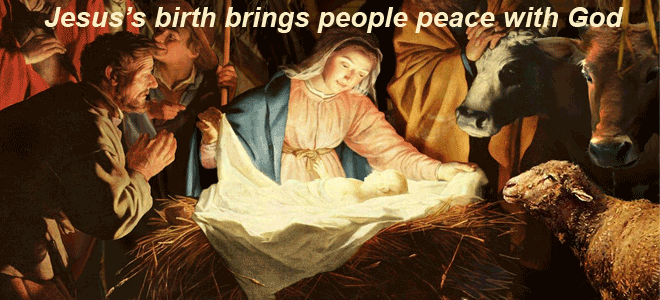 The angels’ message first rang out more than 2,000 years ago, but, especially in the historic Christian liturgy of the Church, their message echoes still today: “Glory to God in the highest, and on earth peace among those with whom He is pleased” (Luke 2:14 English Standard Version). Those with whom God “is pleased”, or, perhaps better, those of His “good will” (King James Version), are those who by faith receive the forgiveness of sins on account of the grace of God for the sake of His Son Jesus Christ, Who was born into human flesh in order to die for the sins of all people, including you!
The angels’ message first rang out more than 2,000 years ago, but, especially in the historic Christian liturgy of the Church, their message echoes still today: “Glory to God in the highest, and on earth peace among those with whom He is pleased” (Luke 2:14 English Standard Version). Those with whom God “is pleased”, or, perhaps better, those of His “good will” (King James Version), are those who by faith receive the forgiveness of sins on account of the grace of God for the sake of His Son Jesus Christ, Who was born into human flesh in order to die for the sins of all people, including you!
To be sure, Christmas, or The Nativity of Our Lord, is an important day of the Church Year, sine qua non (Latin for “without which not”, meaning it is an essential condition, something absolutely necessary). For, without the birth of our Lord, there would be no death and resurrection of our Lord. Yet, as important as our Lord’s birth is, His death is more important, for not His birth but His death pays the price and so earns all people the forgiveness of sins and thereby life and salvation, which believers graciously receive by faith.
Our congregation’s chief observance of Christmas is not the better‑attended Christmas Eve Candlelight Service of Readings and Hymns but the lesser‑attended Divine Service on Christmas Day. The Christmas Eve Candlelight Service is much loved and deservedly so, but the Christmas Day Divine Service is the “Mass of Christ” for which the day gets its more common name. There hardly is a better way to observe our Lord’s becoming flesh (John 1:14) than to eat that flesh in the Sacrament of the Altar, which eating of His flesh and drinking of His blood is necessary for us to have life (John 6:53)!
The Christmas season consists of more than the one day for which it is named and its associated services. For the entire season of Christmas, the altar and other paraments are white, a color most-frequently associated with festivals of Christ. White symbolizes joy, celebration, gladness, light, purity, and innocence—all of which meanings are appropriate for Christmas. Given below are the liturgical and calendar dates for all our observances of the Christmas season, in most cases along with descriptions and citations of their appointed Gospel Readings (according to Lutheran Service Book’s 3‑year Series B).
- Christmas Eve (12/24 at 6:00 p.m.): Candlelight Service of Readings and Hymns (The Sunday School children assist with the Service)
- Christmas Day (12/25 at 10:00 a.m.): Jesus is the Word made flesh
(John 1:1-18) - First Sunday after Christmas (12/28): The infant Jesus goes to the Temple
(Luke 2:22-40) - Second Sunday after Christmas (01/04): The boy Jesus goes to the Temple
(Luke 2:40-52)
Christmas Day and both Sundays of this Christmas season (and all of the Sundays of the 2014-2015 Church Year when Pastor Galler is present) Pilgrim is continuing to offer a full Divine Service with the Sacrament of the Altar. This Church Year we are following the liturgy of Lutheran Service Book’s Divine Service, Setting Three (essentially the same liturgy that the congregation used two years ago as Lutheran Worship’s Divine Service I and which many know from The Lutheran Hymnal pages 15 and following).
You may read and hear sermons preached at Pilgrim during Christmas and any other season of the Church Year here.
The slider graphic and banner graphic on this page were adapted from the uncredited image found here.

